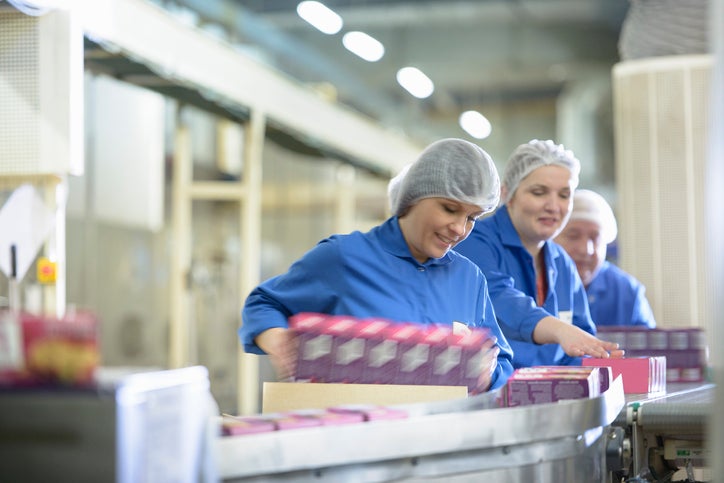
The packaging industry is a sector going through transformative change. From the drive for sustainability, to the development of digitalisation, automation and connectivity, new opportunities are constantly emerging.
However, the battle for gender diversity is an ongoing one. To unpack this disparity, Packaging Gateway speaks to Joanna Stephenson, co-founder of the Women in Packaging initiative, Nancy Wilson, CEO of US-based packaging company Morrison Container Handling Solutions, and Sharron Gilbert, CEO of Septimatech which manufactures machinery for packaging lines.

Discover B2B Marketing That Performs
Combine business intelligence and editorial excellence to reach engaged professionals across 36 leading media platforms.
What are the biggest opportunities for women in today’s packaging industry?
Joanna Stephenson: It would be great to see more women leaders. STEM [science, technology, engineering, and mathematics] businesses traditionally have problems attracting female talent and this is very true in the packaging sector. For example, women are clearly represented in design and the more traditional functions in HR and customer service, but sorely lacking in technical, manufacturing and leadership roles, with very few managing directors present. So there’s gaps there for aspiring women in packaging to fill.
Nancy Wilson: The opportunities are endless. The workforce shortage has opened some doors that were closed before. We all want talented qualified workers regardless of gender.
Sharron Gilbert: The biggest opportunity for women is to have a voice at the table, share their knowledge, insight, and ideas no matter their role or responsibility. The industry faces complex problems and is under serious scrutiny such as the environment and workforce shortages. Women can help create the solutions needed to address many of these challenges. In fact, an industry with diversity of people in gender, ethnicity, race, skillset, age, and experience can do amazing things which make opportunities endless.
What are the biggest challenges for women in today’s packaging industry?
JS: Data is scarce, but the industry is still heavily male dominated when it comes to the manufacturing side of the industry. British Printing Industries Federation data indicates that in the UK there is roughly a 70/30 split male/female but anywhere between an 11% and 30% gender pay gap for women in packaging, which is disappointing. The biggest challenge I see is creating sufficient female role models in the industry for the next generations coming through to recognise the opportunities that are available. And, fundamentally there is insufficient recognition of the packaging industry as a viable career opportunity. If it is in the news, invariably it’s a negative sustainability story and not about the tremendous variety, complexity, and technological advances the sector is actually making. This makes it incredibly difficult to recruit talent – male or female.

US Tariffs are shifting - will you react or anticipate?
Don’t let policy changes catch you off guard. Stay proactive with real-time data and expert analysis.
By GlobalDataNW: Women often have not had the same level of experiences as men while growing up either at school, home, or from initial work experiences. I applaud the efforts to change this through inclusion in robotics teams and other STEM development programmes. These lead to more women taking up space in industries like packaging.
SG: Some of the biggest challenges for women in packaging are potentially the greatest opportunities. We need to expand the number of women in the packaging industry. We need a genuine acceptance that women are the future and a plan to make that happen. Women play an important role by bringing diverse thinking and action. We also need to create awareness about the industry and the many career opportunities available for a purposeful, satisfying, and rewarding career.
How are workplaces in the packaging sector adapting to changing ideas and attitudes of gender in 2023?
JS: Other than gender-neutral bathrooms which are becoming more common, there is very little discussion on the topic in the industry.
NW: Workforce shortages have resulted in more adaptation and flexibility in adapting to needs. There is openness to solutions regardless of where they are coming from.
SG: Overall, the packaging industry is doing well. Some workplaces are doing amazing breakthrough work, others need to do more, some need to walk the talk and unfortunately there are still a few who need to wake up or be left behind. Top-down embrace, leadership, accountability, inclusivity, acceptance, kindness, and love are key to changing ideas and attitudes. Some of these words might not be typical for business, but if we are really changing ideas and attitudes, this is what is needed. When we reflect on our own company the culture is critical. We spend a lot of our life together, and therefore it is important to aspire and wrap our arms around these words in meaningful actions.
Where do you hope the industry will be in five years’ time from a gender perspective?
JS: More balanced! We are struggling to recruit skilled talent into the industry – male or female. However, with increasing awareness of the gender diversity challenge my hope is that businesses will start to move in the right direction.
NW: The goal is when it no longer occurs to us to talk about gender. True equality is achieved when the workforce is the workforce based on skills and abilities.
SG: In five-years’ time it is my hope that we have just as many women as our male counterparts as business owners, running businesses, in key leadership positions, in trades, and traditional and non-traditional roles. I realise that this is a big goal to accomplish. However, it should highlight the time sensitivity and number of career opportunities. Woman have come far in the history of our industry, but there is so much more that needs and can be done to attract, retain, promote, and support women.





